ADX Recombinant Rabbit Monoclonal Antibody [JE63-56]

cat.: HA721329
| Product Type: | Recombinant Rabbit monoclonal IgG, primary antibodies |
|---|---|
| Species reactivity: | Human, Mouse, Rat |
| Applications: | WB, IHC-P, IF-Cell |
| Clonality: | Monoclonal |
| Clone number: | JE63-56 |
| Form: | Liquid |
| Storage condition: | Shipped at 4℃. Store at +4℃ short term (1-2 weeks). It is recommended to aliquot into single-use upon delivery. Store at -20℃ long term. |
| Storage buffer: | 1*TBS (pH7.4), 0.05% BSA, 40% Glycerol. Preservative: 0.05% Sodium Azide. |
| Concentration: | 1ug/ul |
| Purification: | Protein A affinity purified. |
| Molecular weight: | Predicted band size: 19 kDa |
| Isotype: | IgG |
| Immunogen: | Synthetic peptide within Human ADX aa 51-100 / 184. |
| Positive control: | SK-Br-3 cell lysate, K-562 cell lysate, HepG2 cell lysate, 293T cell lysate, Rat liver tissue lysate, Rat testis tissue lysate, Rat kidney tissue lysate, Mouse liver tissue lysate, PC-12, human placenta tissue, rat adrenal gland tissue. |
| Subcellular location: | Mitochondrion matrix. |
| Recommended Dilutions:
WB IHC-P IF-Cell |
1:500-1:1,000 1:200-1:1,000 1:50 |
| Uniprot #: | SwissProt: P10109 Human | P46656 Mouse | P24483 Rat |
| Alternative names: | Adrenal ferredoxin Adrenodoxin Adrenodoxin, mitochondrial ADX ADX_HUMAN FDX fdx1 Ferredoxin 1 Ferredoxin-1 Hepatoredoxin LOH11CR1D Mitochondrial adrenodoxin mitochondrial |
Images
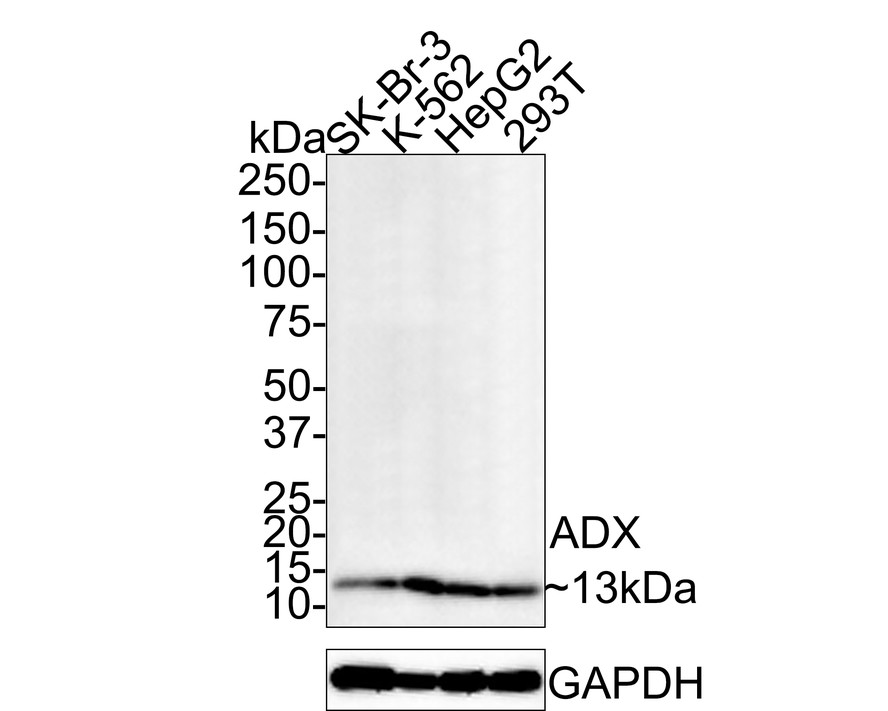
|
Fig1:
Western blot analysis of ADX on different lysates with Rabbit anti-ADX antibody (HA721329) at 1/500 dilution. Lane 1: SK-Br-3 cell lysate (15 µg/Lane) Lane 2: K-562 cell lysate (15 µg/Lane) Lane 3: HepG2 cell lysate (15 µg/Lane) Lane 4: 293T cell lysate (15 µg/Lane) Predicted band size: 19 kDa Observed band size: 13 kDa Exposure time: 5 minutes; 4-20% SDS-PAGE gel. Proteins were transferred to a PVDF membrane and blocked with 5% NFDM/TBST for 1 hour at room temperature. The primary antibody (HA721329) at 1/500 dilution was used in 5% NFDM/TBST at room temperature for 2 hours. Goat Anti-Rabbit IgG - HRP Secondary Antibody (HA1001) at 1:200,000 dilution was used for 1 hour at room temperature. |
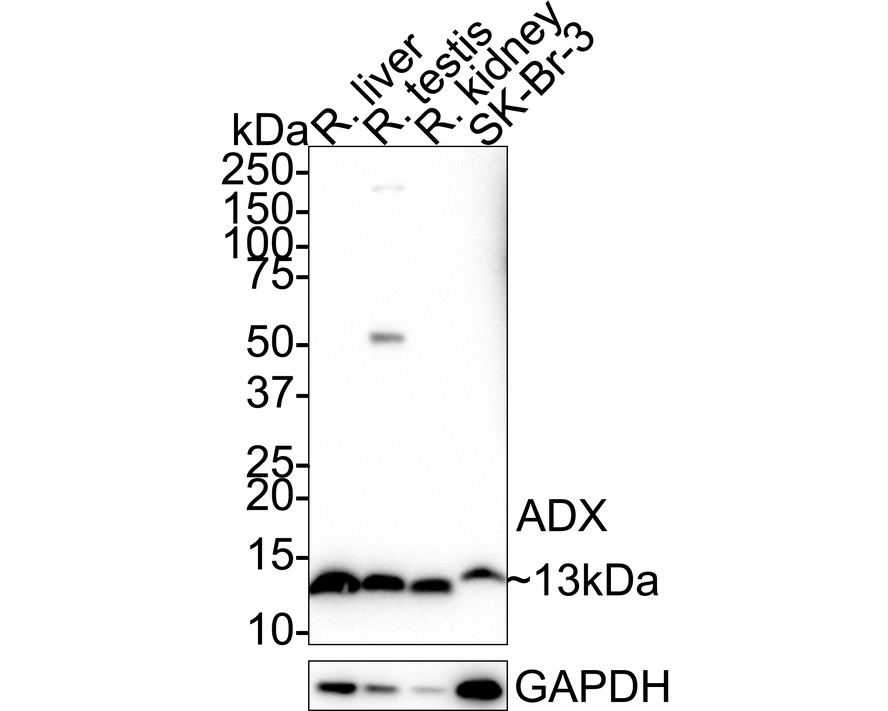
|
Fig2:
Western blot analysis of ADX on different lysates with Rabbit anti-ADX antibody (HA721329) at 1/500 dilution. Lane 1: Rat liver tissue lysate (40 µg/Lane) Lane 2: Rat testis tissue lysate (40 µg/Lane) Lane 3: Rat kidney tissue lysate (40 µg/Lane) Lane 4: SK-Br-3 cell lysate (40 µg/Lane) Predicted band size: 19 kDa Observed band size: 13 kDa Exposure time: 2 minutes; ECL: K1801; 4-20% SDS-PAGE gel. Proteins were transferred to a PVDF membrane and blocked with 5% NFDM/TBST for 1 hour at room temperature. The primary antibody (HA721329) at 1/500 dilution was used in 5% NFDM/TBST at room temperature for 2 hours. Goat Anti-Rabbit IgG - HRP Secondary Antibody (HA1001) at 1/50,000 dilution was used for 1 hour at room temperature. |
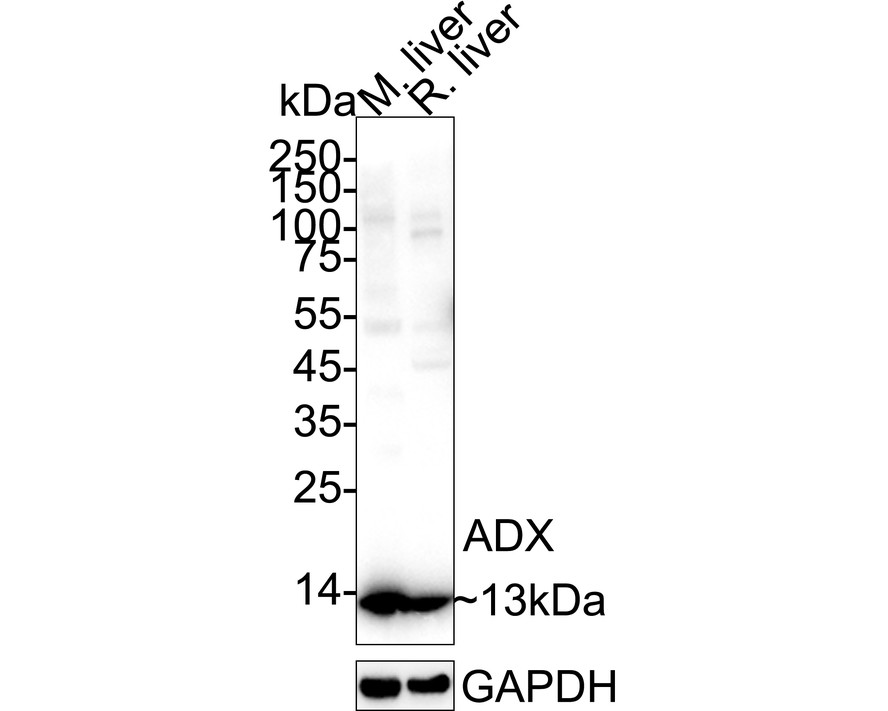
|
Fig3:
Western blot analysis of ADX on different lysates with Rabbit anti-ADX antibody (HA721329) at 1/1,000 dilution. Lane 1: Mouse liver tissue lysate Lane 2: Rat liver tissue lysate Lysates/proteins at 40 µg/Lane. Predicted band size: 19 kDa Observed band size: 13 kDa Exposure time: 10 seconds; ECL: K1801; 4-20% SDS-PAGE gel. Proteins were transferred to a PVDF membrane and blocked with 5% NFDM/TBST for 1 hour at room temperature. The primary antibody (HA721329) at 1/1,000 dilution was used in primary antibody dilution (K1803) at 4℃ overnight. Goat Anti-Rabbit IgG - HRP Secondary Antibody (HA1001) at 1/50,000 dilution was used for 1 hour at room temperature. |
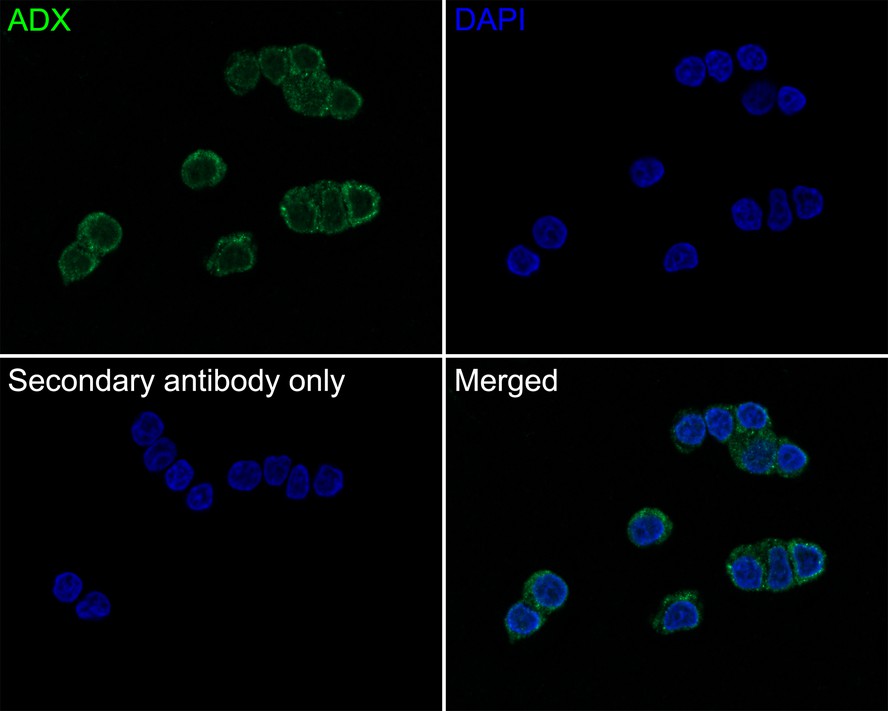
|
Fig4:
Immunocytochemistry analysis of PC-12 cells labeling ADX with Rabbit anti-ADX antibody (HA721329) at 1/50 dilution. Cells were fixed in 4% paraformaldehyde for 10 minutes at 37 ℃, permeabilized with 0.05% Triton X-100 in PBS for 20 minutes, and then blocked with 2% negative goat serum for 30 minutes at room temperature. Cells were then incubated with Rabbit anti-ADX antibody (HA721329) at 1/50 dilution in 2% negative goat serum overnight at 4 ℃. Goat Anti-Rabbit IgG H&L (iFluor™ 488, HA1121) was used as the secondary antibody at 1/1,000 dilution. PBS instead of the primary antibody was used as the secondary antibody only control. Nuclear DNA was labelled in blue with DAPI. |
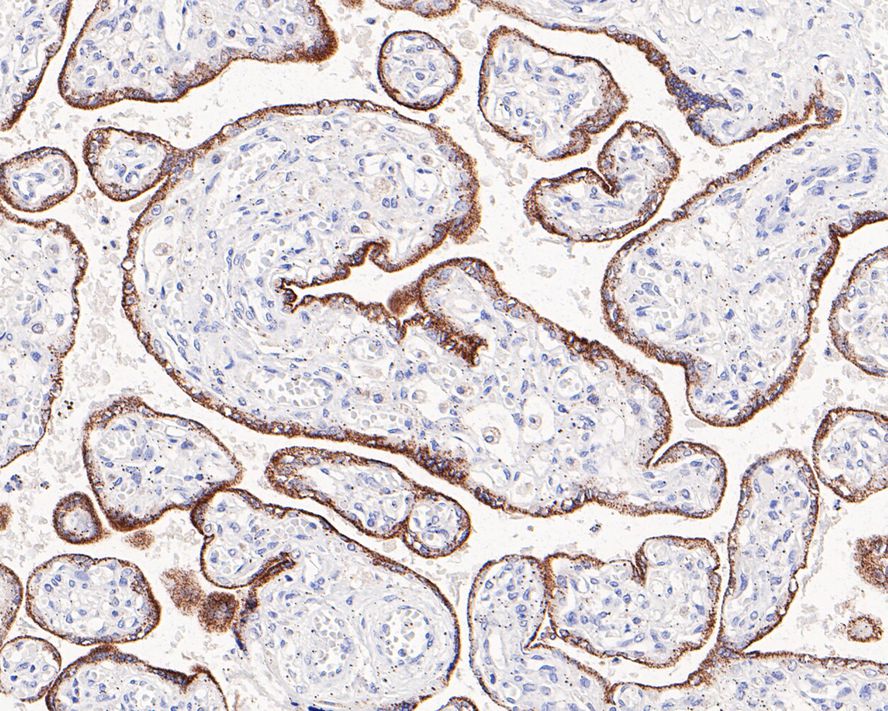
|
Fig5:
Immunohistochemical analysis of paraffin-embedded human placenta tissue with Rabbit anti-ADX antibody (HA721329) at 1/200 dilution. The section was pre-treated using heat mediated antigen retrieval with Tris-EDTA buffer (pH 9.0) for 20 minutes. The tissues were blocked in 1% BSA for 20 minutes at room temperature, washed with ddH2O and PBS, and then probed with the primary antibody (HA721329) at 1/200 dilution for 1 hour at room temperature. The detection was performed using an HRP conjugated compact polymer system. DAB was used as the chromogen. Tissues were counterstained with hematoxylin and mounted with DPX. |
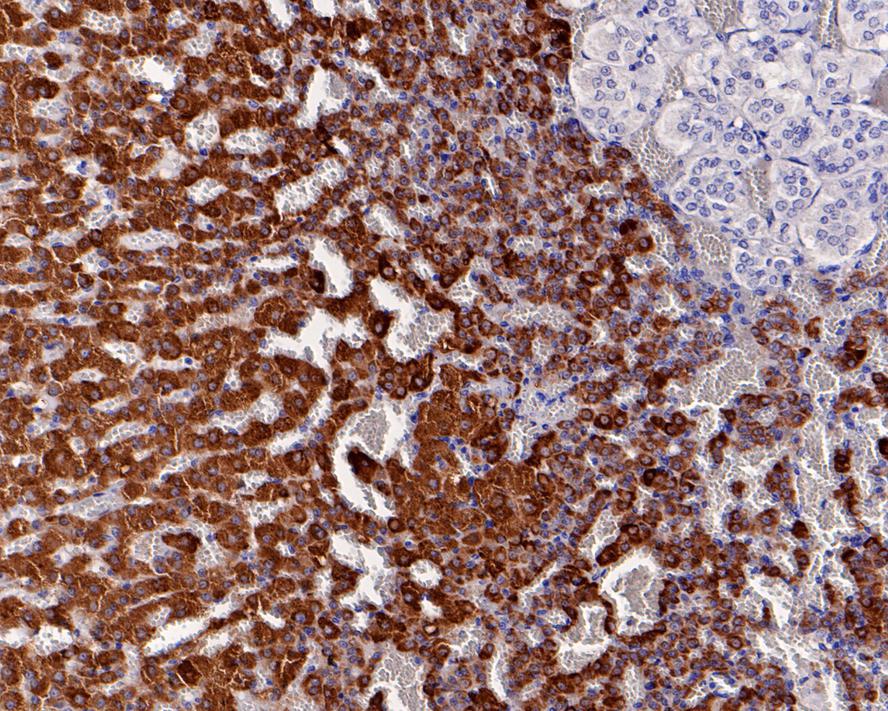
|
Fig6:
Immunohistochemical analysis of paraffin-embedded rat adrenal gland tissue with Rabbit anti-ADX antibody (HA721329) at 1/1,000 dilution. The section was pre-treated using heat mediated antigen retrieval with Tris-EDTA buffer (pH 9.0) for 20 minutes. The tissues were blocked in 1% BSA for 20 minutes at room temperature, washed with ddH2O and PBS, and then probed with the primary antibody (HA721329) at 1/1,000 dilution for 1 hour at room temperature. The detection was performed using an HRP conjugated compact polymer system. DAB was used as the chromogen. Tissues were counterstained with hematoxylin and mounted with DPX. |
Note: All products are “FOR RESEARCH USE ONLY AND ARE NOT INTENDED FOR DIAGNOSTIC OR THERAPEUTIC USE”.